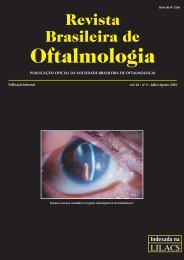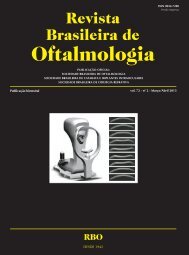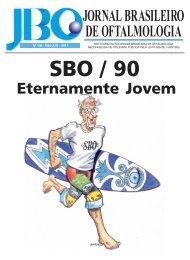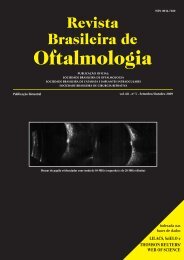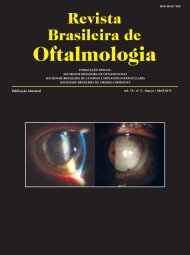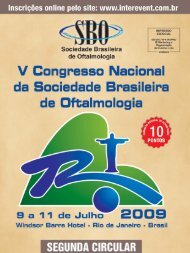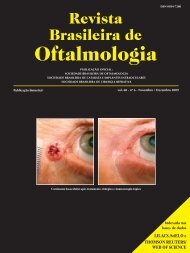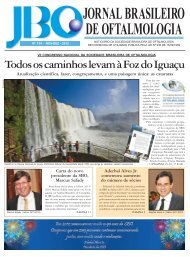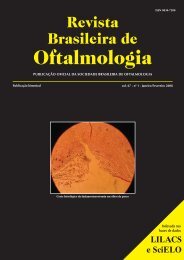Jul-Ago - Sociedade Brasileira de Oftalmologia
Jul-Ago - Sociedade Brasileira de Oftalmologia
Jul-Ago - Sociedade Brasileira de Oftalmologia
- No tags were found...
Create successful ePaper yourself
Turn your PDF publications into a flip-book with our unique Google optimized e-Paper software.
Comparison between OPD-scan results and contrast sensitivity of three intraocular lenses: spheric AcrySof SN60AT ...221precise axial length measurements provi<strong>de</strong>d to allpatients an excellent uncorrected and best corrected finalvisual acuity at high contrast in ETDRS 100% chart.The visual acuity in low contrast settings tested withETDRS 9% chart, all groups have an equal efficiency,but with a ten<strong>de</strong>ncy to best performance in the WF group.There are no studies in the review of current literaturepublished using this test to compare visual performancein pseudophakic patients using multifocal and other IOLs.The monocular contrast sensitivity, at photopicconditions the SN60AT and SN60WF IOLs had gonebetter than SA60D3 without statistical significance,according with previous studies published, while othersstudies showed a statistically difference between theSA60AT and SA60D3 groups (10,23) . In mesopic conditionsthere were no statistical difference between the 3 groups.Other study showed lower contrast sensitivity un<strong>de</strong>rmesopic conditions in multifocal IOLs that usedrefractive technology (24) . Aberrations cause incominglight that would otherwise be focused to a point to beblurred, which in turn causes a reduction in visual quality.This reduction in quality is more severe un<strong>de</strong>r lowluminance conditions because spherical aberrationincreases when the pupil size increases. More attentionshould be <strong>de</strong>voted to the relation between wavefrontanalysis and visual performance, and reassessment oftheir clinical significance is nee<strong>de</strong>d.In conclusion, in all analyzed parameters of OPDscanaberrometry the aspheric and the multifocal IOLsprovi<strong>de</strong>d less total and spherical aberrations than sphericIOLs. All IOLs provi<strong>de</strong>d an excellent high and lowcontrasts vision, the multifocal IOL was as good as thespheric and aspheric monofocal IOLs.AcknowledgementsThis study was presented previously in Universityof São Paulo Ophthalmology Congress in november2006. There were no financial support or interest in theequipment or method mentioned, no research ortraveling grant support, no consulting services provi<strong>de</strong>d,or commercial and proprietary interest.RESUMOObjetivo: Comparar a sensibilida<strong>de</strong> ao contraste e análise<strong>de</strong> “wavefront” com OPD-scan em pacientes submetidos acirurgia <strong>de</strong> facoemulsificação com implantes <strong>de</strong> lentesintraoculares AcrySof SN60D3 multifocal, AcrySofSN60WF monofocal asférica e AcrySof SA60ATmonofocal esférica. Métodos: Trinta e dois olhos com alente intraocular multifocal, 32 olhos com a lenteintraocular monofocal asférica e 32 olhos com a lenteintraocular monofocal esférica. A avaliação oftalmológicafoi realizada no primeiro, terceiro, sétimo, e nonagésimodia pós-operatório. Todos os exames foram padronizados,realizada por um único examinador sob condições controladas<strong>de</strong> luminosida<strong>de</strong> fotópicas estabelecidas em 85 cd/m 2 , medida por meio <strong>de</strong> tabelas <strong>de</strong> ETDRS, sensibilida<strong>de</strong>ao contraste e análise <strong>de</strong> aberrometria com OPD-Scan.Resultados: As médias <strong>de</strong> aberração total foi superior nogrupo SN60AT (KW = 9.42; p=0.009) quando comparadacom o grupo SN60D3 (p=0.016) e o grupo SN60WF(p=0.0047). O grupo SN60AT (KW = 16.20; p=0.0003)apresentou superiorida<strong>de</strong> nas medias <strong>de</strong> aberração esféricacomparada com o grupo SN60WF (p=0.00046) e o grupoSN60D3 (p=0.0014). Nenhuma diferença significantefoi encontrada na acuida<strong>de</strong> visual para longe com e semcorreção óptica com a tabela <strong>de</strong> ETDRS a 100% e 9% <strong>de</strong>contraste. O grupo SN60D3 comparada a SN60AT(p=0.016) apresentou baixa sensibilida<strong>de</strong> ao contraste emcondições fotópicas com diferença estatística a 6.0 cpg (KW= 7.84; p=0.0199), mas sem diferença estatística entre osgrupos SN60WF e SN60AT (p=0.91) e entre os gruposSN60WF e SN60D3 (p=0.051). O grupo SN60D3 apresentoubaixa sensibilida<strong>de</strong> ao contraste em condiçõesmesópicas (KW = 10.79; p=0,0045) a 6cpg quando comparadacom o grupos SN60AT (p=0.011) e SN60WF(p=0.007). Conclusão: As lentes intraoculares multifocaise asféricas apresentaram menos aberração esférica quandocomparadas à lente intraocular esférica, além da previstamultifocalida<strong>de</strong> sem correção para longe e perto.Entretanto, o grupo multifocal apresentou baixa sensibilida<strong>de</strong>ao contraste.Descritores: Lentes; Lentes intraoculares; Sensibilida<strong>de</strong><strong>de</strong> contraste; Facoemulsificação; VisãoREFERENCES1. Obuchowska I, Mariak Z. [Sir Harold Ridley—the creator ofmo<strong>de</strong>rn cataract surgery]. Klin Oczna. 2005;107(4-6):382-4.Polish.2. Dietze HH, Cox MJ. Limitations of correcting spherical aberrationwith aspheric intraocular lenses. J Refract Surg.2005;21(5):S541-6.3. Guirao A, Redondo M, Geraghty E, Piers P, Norrby S, Artal P.Corneal optical aberrations and retinal image quality in patientsin whom monofocal intraocular lenses were implanted.Arch Ophthalmol. 2002;120(9):1143-51.4. Alió JL, Schimchak P, Negri HP, Montés-Micó R. Crystallinelens optical dysfunction through aging. Ophthalmology.2005;112(11):2022-9. Comment in: Ophthalmology.2007;114(3):618; author reply 619.5. Rawer R, Stork W, Spraul CW, Lingenfel<strong>de</strong>r C. Imaging qualityof intraocular lenses. J Cataract Refract Surg.2005;31(8):1618-31.Rev Bras Oftalmol. 2009; 68 (4): 216-22



